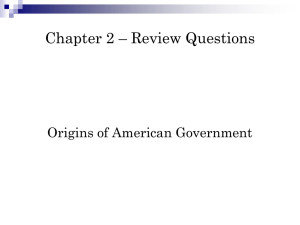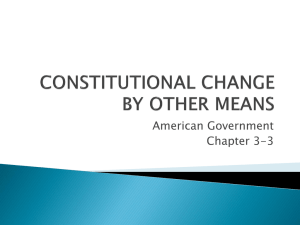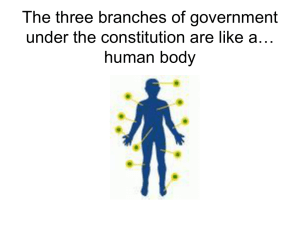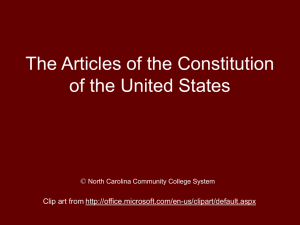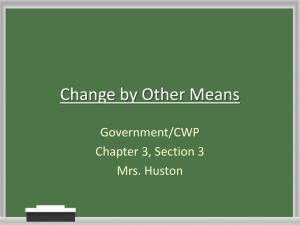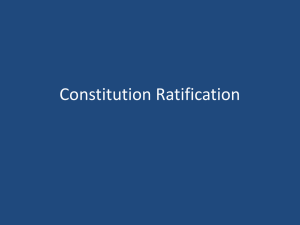The Constitution`s Sources
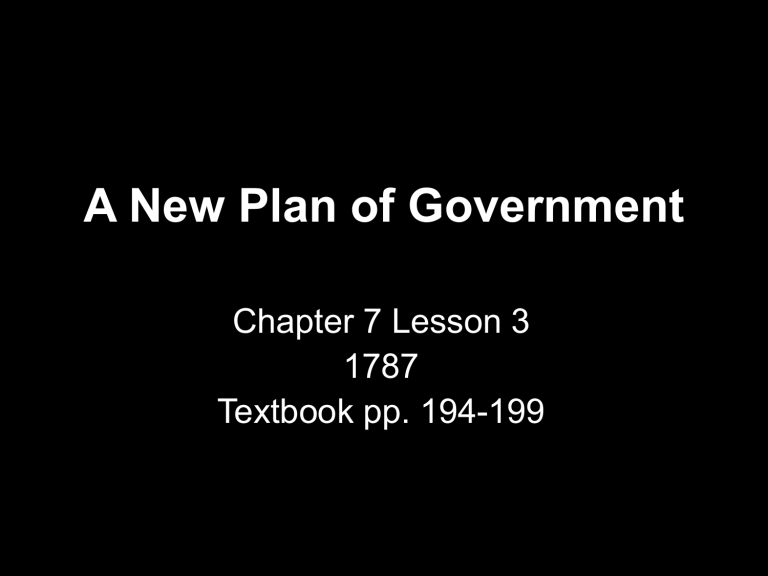
A New Plan of Government
Chapter 7 Lesson 3
1787
Textbook pp. 194-199
The Constitution’s Sources
The _________ were the men who shaped the
Constitution.
The Constitution’s Sources
The Framers were the men who shaped the
Constitution.
The Constitution’s Sources
The Constitution’s Sources
European Influences
The belief that all people have a right to ____,
_______, ____________ was promoted by philosopher __________.
European Influences
The belief that all people have a right to life, liberty, and property was promoted by philosopher John Locke.
European Influences
• ___________ argued for
____________________ powers among the legislative, executive, and judicial ___________
__________. He believed that this would help guarantee __________
______.
European Influences
• Montesquieu argued for separate and balanced powers among the legislative, executive, and judicial branches of government. He believed that this would help guarantee individual liberty.
Federalism
A system of government where power is
________________________________ governments is called federalism.
Federalism
A system of government where power is shared between the national and state governments is called federalism.
Government Branches
The branch of government that makes laws is called the ___________ branch and is called
Congress by the Constitution.
Congress is made up of the
_____ of Representatives and the ______.
Congress can tax, draft people into the army, declare war, coin money, and regulate trade.
Government Branches
The branch of government that makes laws is called the legislative branch and is called
Congress by the Constitution.
Congress is made up of the
House of Representatives and the Senate.
Congress can tax, draft people into the army, declare war, coin money, and regulate trade.
Government Branches
The branch of the government that is headed by the _________ is called the _________ branch.
The executive branch “executes” or carries out the laws that Congress passes.
Government Branches
The branch of the government that is headed by the president is called the executive branch.
The executive branch “executes” or carries out the laws that Congress passes.
Government Branches
The branch of government that deals with the
__________ is called the ________ branch.
“The Supreme Court and other federal courts hear cases involving the Constitution, federal laws, and disputes between states.”
Discovering our Past, p. 197
Government Branches
The branch of government that deals with the court system is called the judicial branch.
“The Supreme Court and other federal courts hear cases involving the Constitution, federal laws, and disputes between states.”
Discovering our Past, p. 197
Government Branches
The _________________ is the group of people that indirectly elects the president.
Government Branches
The Electoral College is the group of people that indirectly elects the president.
Electoral College School House Rock song
Checks and Balances
“Checks and balances” is a system that keeps any one branch of government from gaining too much power.
Each branch can “_____” or ______________ of the other two branches.
Checks and Balances
“Checks and balances” is a system that keeps any one branch of government from gaining too much power.
Each branch can “check” or limit the power of the other two branches.
Checks and Balances
Examples:
Congress can ____ a law. The president can ____ it. Congress can ______ the veto.
The Supreme Court can interpret the
Constitution and _________ legislation.
Congress can check decisions made by the
Court by ________ the Constitution or revising legislation.
Checks and Balances
Examples:
Congress can pass a law. The president can veto it. Congress can override the veto.
The Supreme Court can interpret the
Constitution and strike down legislation.
Congress can check decisions made by the
Court by amending the Constitution or revising legislation.
Look at the relationships between the branches of government in this chart…
Federalists and Anti-Federalists
• The ___________ were __ the Constitution.
Federalists and Anti-Federalists
• The Federalists were for the Constitution.
Federalists and Anti-Federalists
• _____________, were
_______ the Constitution and feared the national government would ____
_________ from people.
• The Anti-Federalists also favored local government
__________ more closely
______________.
Federalists and Anti-Federalists
• Anti-Federalists, were against the Constitution and feared the national government would take rights away from people.
• The Anti-Federalists also favored local government controlled more closely by the people.
Ratifying the Constitution
Rhode Island became the last state to ratify or
_______ the Constitution in May 1790.
Ratifying the Constitution
Rhode Island became the last state to ratify or approve the Constitution in May 1790.


